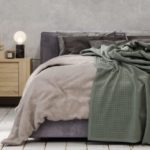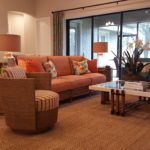When shopping for a new look for your home, it can be easy to fall into some common design mistakes. You find an item you love and want to impulse buy, but unfortunately it may be perfect, but not perfect for your space. Let’s review some of the furniture buying mistakes and how to avoid them.
Scale and Proportion
As explained by Interior Designer, Linda Floyd, “When you enter a room, it should be like a cityscape – a combination of different heights. You never want everything in the room to be the same level or size”.
Too many small items scattered in a room can overwhelm a space, giving a cluttered appearance that doesn’t allow the eye to fall on one place. Meanwhile, items too large for the space, can make the room look overstuffed and smaller than it actually is. The key to proper scale is to provide a mixture of different shapes, heights and sizes. This can be a key step in designing your room successfully.
No Focal Point
A focal point allows us to assign a function to the room, and gives us a true place to look when walking into the space. Some rooms can have multiple focal points such as a television for entertainment, and an ocean view for times when relaxing is priority. Each room should have a purpose which is created with the focal point.
The most difficult rooms to find a focal point for can be the study or den. The idea is to find a purpose for the room, don’t just scatter different furniture pieces around, hoping to fill in space. A fireplace, large painting, intricate piece of furniture, or even a rug can become a focal point in a room, as long as the furniture is placed in order to draw your attention to that item.
The Wrong Size Rug
A rug plays a large role in the design impact of your room, therefore it is incredibly important to get this right. When discussing rugs, we’re going to focus on the living room, which is one of the most common spaces where rug sizes can be a big mistake.
When designing a space, there are 3 key options to keep in mind when picking a rug for the space.
- Let The Rug Be – Allow the rug to stand alone in the space with limited furniture on top of it. This is a great option for those that are on a budget, or have a small space they don’t want to overwhelm. A smaller rug can help create symmetry and ground your ottoman or coffee table to make it a centerpiece of a room.
- Half On / Half Off – This scenario can still require a decent amount of spacing for your rug. Your goal is to provide half of your furniture with a rug, while the other half frames the rug and creates a defined space. This can have all the same benefits of the larger rug, but allows the space to feel more open and defined, which can be beneficial in a smaller space, or when having an open floor plan with multiple rugs.
- The Bedrock Rug – Creating a foundation for your furniture can be easy when you use a rug that fills the design space. Having all items of furniture completely on the rug provides a snug and cozy feeling that easily creates the layout of your room, while providing a source of warmth and color.
Mistakes happen. When working in the same space for weeks or months, it can be hard to spot out our mistakes. Some of the best advice we can give for not making a mistake: ask for help! A fresh pair of eyes can make a big difference on how you see your design space, and some good news for you – Hudson’s Furniture has certified designers on staff just waiting to help you with your furniture design needs!
Jessica DeVaney
Regional Design Manager
Ocala, FL


